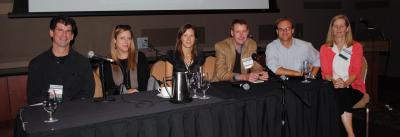By Ameé J. Salois
What would you do for the story of your dreams? Could you turn down The New York Times when it made an impossible request?
Paige Williams did. After the popular book “Possum Living“ by Dolly Freed was reprinted in 2008, Williams realized that Dolly Freed had literally disappeared. Freed wrote the book with a 7th grade education at the age of 18. After her parents divorced, her father took her out of school, and for five years, the pair lived, as the book's cover says, “without a job and with (almost) no money.” Williams was determined to find out what had happened to the spunky 18-year old who lived off of the land.
After some searching, Williams discovered that Dolly Freed was living in Texas and working for NASA as an investigator into the Challenger tragedy, but still living off of the land. The New York Times was immediately intrigued by the story. However, just days before the release, the Times asked Williams to reveal the real name of Dolly Freed (which had been kept secret for privacy and because some actions confessed in “Possum Living” were not entirely legal). Williams would not do it, and The New York Times said ‘Farewell.’Left with an amazing story that needed to be published, Williams self-published, something she does not recommend as a habit. Starting a website with a Paypal “Support the Journalist” request in the corner, Williams was able to hire a photographer, editor, and fact checker. It may not be in The New York Times, but the response from people was positive and the story that Williams could not let go was released into the world. As Williams said at the workshop, “I was just happy to birth it.”
In fact, all of the authors in the workshop “How to Sell that Story You Can’t Let Go” spoke of such passion for the stories they wished to publish that they would do almost anything to see them enter the world.
David Dobbs shared a story from his own past. Just before his mother passed away, she shared a riddle with Dobbs. She requested that her ashes be spread over the waters surrounding Hawaii so that she might be with the man she had met sixty years before, during World War II. It was a secret love affair with a man known as Angus, a married flight surgeon. He had disappeared afterwards and Dobbs was determined to uncover his fate. The only problem was no one would take the story.
For ten years the story sat on the shelf while the pitches went out and came back rejected until finally a new, completely digital media platform called The Atavist showed an interest. “Boom! The next thing you know it’s out — within three days it was a #1 Kindle single,” Dobbs said in the workshop. The piece quickly jumped to number sixteen of all Kindle books. After ten years of pitches Dobbs described a piece so close to his heart as “its own machine that catches fire.”
Mark Schrope said it can be a mistake to limit yourself to one or two particular outlets you believe your story to be right for. After a visit to Indonesia, Schrope decided to pursue a story detailing the natives’ relationships with the surrounding coral reefs. Smithsonian was Schrope’s immediate choice for a publisher. Unfortunately, its editors were not interested in the story. After much thought Schrope realized that Smithsonian didn’t have to be the only magazine he pitched to. With much more hard work, including a trip to Fiji to drink the slightly euphoria-inducing Kava with island chiefs, Schrope saw his piece, “Fiji: Where the Chiefs Rule the Reefs,” published in Sport Diver magazine, originally an unlikely outlet for his work.
Hillary Rosner shared her passion for bringing to light the collection and safe-keeping of seeds near the North Pole which may someday save us all. Again, this story was continually turned down even though Rosner had already traveled to Iceland to research the project. One day Popular Science showed an interest, but suggested a different spin on the story. Its editors wanted to know about the people gathering the seeds. Rosner shared her realization in the workshop, “Maybe I’m not trying to tell the right story.” With some inventive changes to the piece and a trip to Africa, Popular Science published Rosner’s “Seeds to Save a Species.”
Finally, Tom Zoellner spoke about the time he nearly went bankrupt so that he might travel to Africa and research diamonds for his heartfelt book, "The Heartless Stone.” Zoellner found inspiration for his book after being turned down for a marriage proposal, which left him wondering about the ring he had already bought and why we, as a society, find it necessary to present this particular gem as a sign of love. He described the pitch process in the workshop as, “rejection, rejection, rejection, and then a tiny offer ... I would have paid them (to publish the book.)”
Some advice from these five speakers on selling that story you can’t let go includes:
- Rework the story.
- Share the piece with someone you trust. Get a fresh set of eyes on it for advice.
- Look for the story within the story — what makes it unique.
- Look for ways to tie in eternal life themes.
- Find the quirky characters and make them come alive in your story.
- Do not limit the story to a specific outlet(s). Find more.
- Upon sending a pitch, prepare it to go out to the next outlet immediately so that upon a rejection you can immediately put it back out there and put the rejection in the past.
- Do not become discouraged because there is always another platform to pitch.
- Make the work something that keeps you going on a deep, personal level.
- Do not give up. Do not say die.




